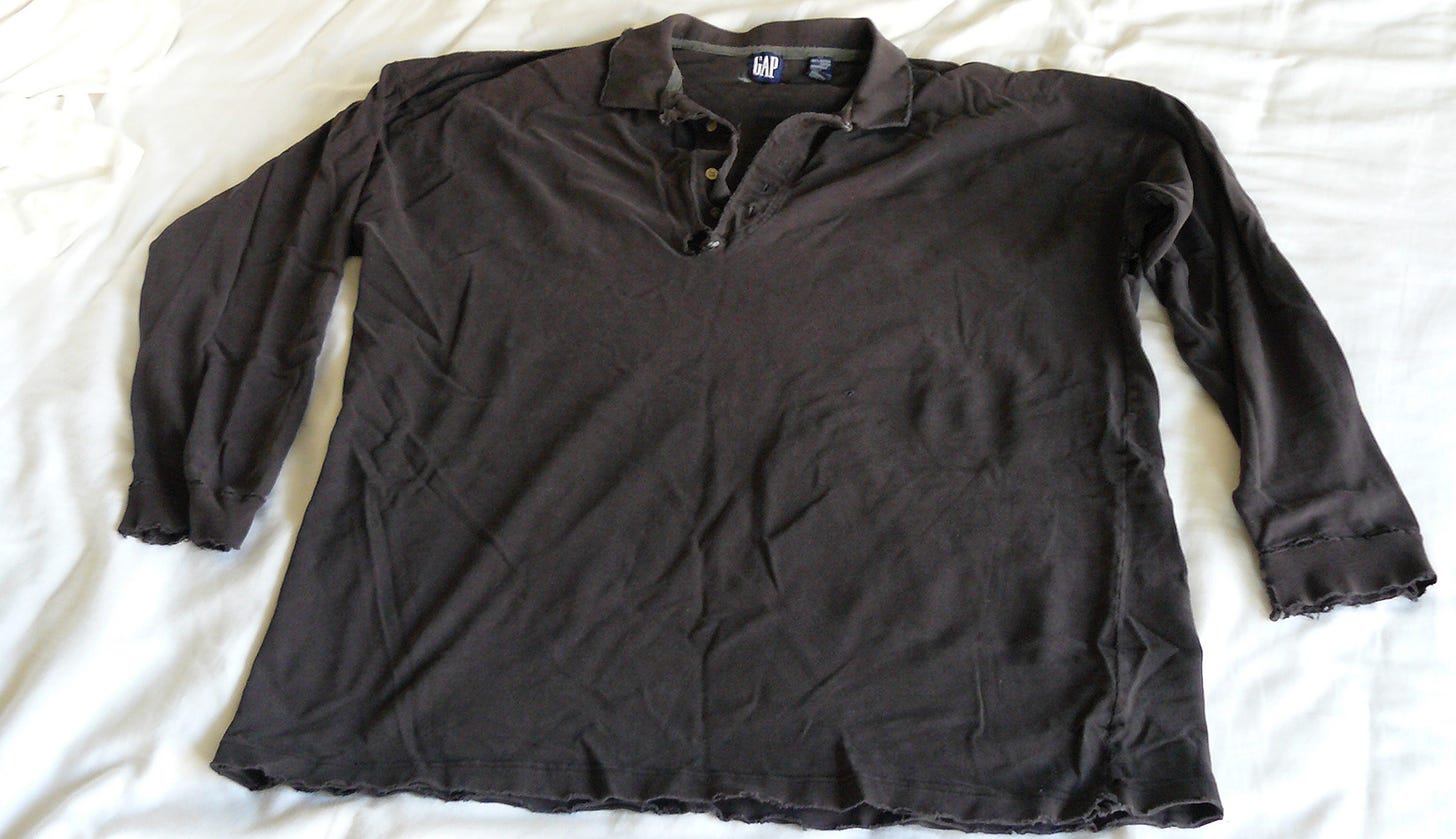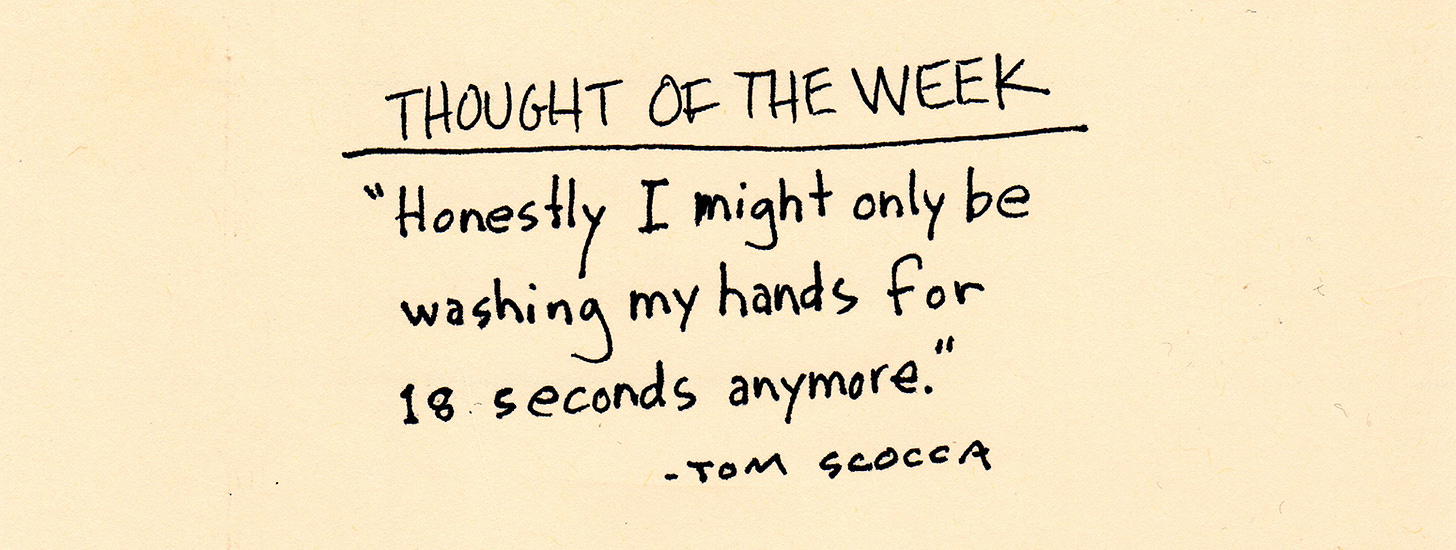DISPOSSESSIONS:
LONG-SLEEVED BLACK GAP SHIRT
EVERYTHING WORTH LOVING has something wrong with it. This shirt was oddly stiff and heavy when I got it, in the summer of 1989, as I picked out the new clothes I would be wearing at college. The cotton fabric had the weight and inflexibility of the first and best rugby shirt I'd owned, a gift from my aunt raising her kids on the Main Line, which had sleeves striped in royal blue and gold and a body in a totally different blue, navy, with thin red striping at the bottom. I'd had to learn how to wear that shirt, physically and culturally, in my distinctly unpreppy school, until it had become the favorite shirt of my early teens.
Now I was on my way to turning 18 and this new shirt was all black—a faintly rusty, brown-tinted black, whose particular tone failed to harmonize with any other black, which helped spare me, after one or two experiments, from ever spending time as the sort of person who would go around wearing black from top to bottom. All I could see if I tried it was the inconsistencies.
The shirt had a four-button placket and a wide, boxy cut. We're past the difficulties here; the cut was perfect. If you were carrying 140 pounds on a six-foot frame on your way into the 1990s, there could not have been a better shirt to hang over it all. The hem was square and long, which was helpful: where I was from, we sagged our jeans down below our boxers, so that given the way I was built through the waist and rear, there was nothing to really hold up my belt before it caught on the protruding tops of my thighbones. When I studied hominid anatomy in college, I would learn that protrusion was called the greater trochanter. The shirt reached it.
I wore the shirt everywhere, as often as possible, pausing only when the summers got too hot. It was what I put on when I wanted to feel most directly like myself. My supply of socks and underwear was only good for two weeks, at the outer limit, so laundry time would come quickly and the shirt would come up clean again. Picturing scenes from that era now, I remember or automatically assume I was wearing it: riding the train to see the Pixies outdoors with Love and Rockets, a little wan and foggy from donating blood for the first time; sitting in an open ground-floor window with a magnolia in bloom outside and loud music playing behind me; finding my footing in thin, still-descending night snow, with people I'd just fallen in with and would never see again afterward.
It was good for any sort of show. I know for sure I wore it to see Social Distortion and Screaming Trees at a club called the Channel, because in the darkness of the mosh pit I became suddenly aware of the repulsive damp sensation of other people sweating through the thick fabric from the outside in, faster than I could sweat from the inside out. It was good for parties; the washing machine would take care of the spilled beer. Given the growth of my wardrobe through the years, and the narrowing of my routine, it seems safe to say that the shirt must have seen more sunrises in more different locations than any other shirt I've owned.
My roommate—we had a lot of roommates in our rooms, but this was the one I chose to bunk with—liked to call it my James Spader shirt, after the actor's outfit in Sex, Lies and Videotape. The movie had come out in the fall of 1989. In it, James Spader is an emotionally and sexually stunted guy who makes a big deal out of living unencumbered and, in service of that simplicity, never wears anything but blue jeans and a series of identical black button-up shirts. Not placket shirts, I would argue. I did have shaggy blond hair to my collar, not unlike James Spader's in the movie, but then I kept growing it for all four years till it went past the collar, past the shoulders, and all the way down to my elbows.
That didn't stop my roommate from continuing to claim I looked like James Spader. I took it mainly to be an ethnic slur about my being a blond Gentile, but something about my looks then and now makes people try to figure out who I remind them of, even though the points of reference they pick rarely look very much like each other, let alone like me. The bad guy in The Karate Kid was another one I would get, and Macauley Culkin after he grew up, but he was still just a child actor back then. It was all so arbitrary it stopped being either insulting or flattering—although, at my roommate's wedding, I had recently gotten a very nice haircut, and one of his elderly relatives went out of her way to tell me I looked like "a young Robert Redford," which was sweet but wildly inaccurate.
Certainly no one would have cast my college-aged self as any sort of Gatsby figure. In lieu of a luxurious pile of shirts I had this one, over and over, paired with jeans or Army surplus shorts. The jeans and shorts were frayed and beat up from use as fast as I could beat them up, enchanted as I was by the knowledge my clothes could be worn out rather than simply outgrown. I refused to buy anything "distressed"—that was cheating, and the real effect was so easy to earn.
Over time, even the near-indestructible shirt began to accumulate signs of age: a dark pearly smoothness where the surface of a button was eroding away, frayed spots on the sturdy cuffs and around the hem, a little rip below the placket, from accumulated torque. All of this, in its proper time and setting, only made me love the shirt more. But four years went by, and then another year or two. I got my hair chopped back to a bob, then to the longest sort of haircut that could pass for short hair. The frayed parts of the shirt became more obvious. It seemed less and less excusable to wear it to the office, or out to interview the public. I wore more presentable things, when I had to present myself, and it became a thing to put on for weekends, while doing chores. Eventually it just stayed in the closet.
At some point, I understood I was never going to wear it again. It had been everything it could be, and there was nothing more I could get out of it, so I took some pictures of it and threw it away. Now even that photo was more than a decade ago. A couple of years ago, Uniqlo started making plain black flannel shirts, and I started buying them to wear with jeans. In lockdown, I've been wearing them over and over, until if anyone pointed out the Sex, Lies, and Videotape resemblance, I'd have no defense. But who really cares what I dress like anymore?
THOUGHT DEP’T.
Do you have a thought? Send it to hmmweekly@hmmweekly.com.
Another Week, Another HMM WEEKLY
GOOD MORNING! This is the latest HMM WEEKLY, successor publication to HMM DAILY, distributed via SUBSTACK, a newsletter delivery and reading platform.
We offer paid subscriptions for full access to HMM WEEKLY posts, with intermittent postings available free as we see fit.
We urge you to spread the word about HMM WEEKLY, and we encourage you to correspond with us! Email hmmweekly@substack.com. Thank you for reading.
REMINDER DEP’T.
THE SOPHIST is here to tell you why you're right. Send your questions to AskTheSophist@hmmweekly.com, and get the answers you want.
SANDWICH RECIPES DEP’T.
WE PRESENT recipes for sandwiches from Salads, Sandwiches and Chafing Dish Recipes, Copyright 1916, by David McKay, Publisher, and now in the public domain for the delectation of all, written by Marion Harris Neil, M.C.A., former Cookery Editor, The Ladies’ Home Journal, author of How to Cook in Casserole Dishes, Candies and Bonbons and How to Make Them, Canning, Preserving and Pickling, and The Something-Different Dish.
History dates the sandwich from 1758. In that year the Earl of Sandwich rebelled once and for all against the tyranny of meal times, whereby each day the hours of gambling were curtailed. Therefore, calling to the waiter,—who, having announced dinner, hovered uneasily round the table,—the Earl ordered that pieces of meat should be laid between two slices of bread, and brought to him as he sat at play. This was done, and the sandwich was born.
AFTERNOON TEA SANDWICHES
Rich pie crust
2 egg-whites
2 ozs. (1/4 cup) sugar
1 oz. (1/4 cup) chopped dates
1 oz. (1/4 cup) chopped nut meats
1/2 teaspoonful almond extract
1 oz. (1/4 cup) chopped preserved ginger
Roll out the pastry very thin, sprinkle with sugar, and cut with cutters into fancy shapes, and bake in a hot oven to a delicate brown. Spread one-half of the pastries with the filling, put together like sandwiches, and return to the oven for a few minutes.
For the filling, beat up whites of eggs to a stiff froth, then beat in the sugar, add the extract, dates, nuts, and ginger.
ANCHOVY SANDWICHES
12 anchovies
4 tablespoonfuls anchovy paste
1/2 lb. (1 cup) sweet butter
6 tablespoonfuls chopped parsley
6 drops green color
1 teaspoonful chopped chives
8 drops red color
Buttered brown bread
Cream one-half of the butter, add the parsley, chives, and green color, mix well, and spread one-fourth of an inch thick on one piece of buttered brown bread. Cream the remaining butter, add the anchovy paste, the anchovies skinned and pounded to a paste, and the red color, mix well, then spread one-fourth of an inch thick on buttered brown bread, place on top of the green, and cut into fancy shapes.
A sandwich of anchovy paste and whipped cream makes its appeal when properly prepared.
If you decide to prepare and enjoy the above item, kindly send a picture to us at hmmweekly@substack.com.
HMM WEEKLY IS written by Tom Scocca, editor, and Joe MacFancy, creative director. If you enjoy Hmm Weekly, please let a friend know about it! If you're reading this because someone forwarded it to you, we invite you to sign up for a copy of your own right now. Thanks for reading, and any time you want, email us at hmmweekly@substack.com.








